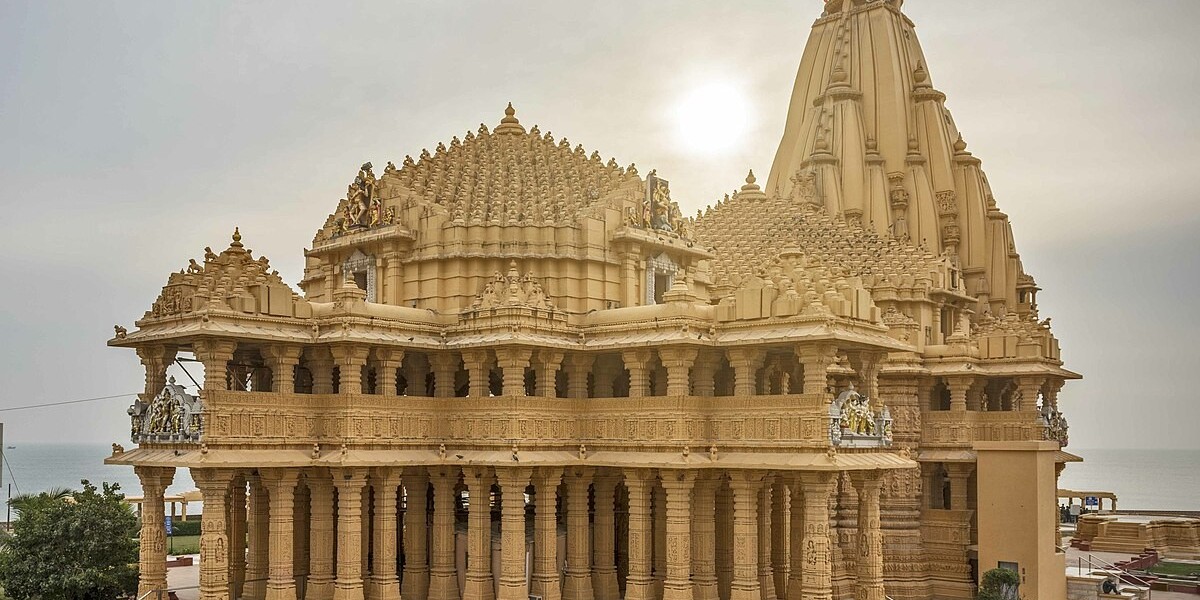India, with its deep-rooted spiritual traditions, is home to numerous sacred sites that narrate tales of faith, destruction, and rebirth. Among these, the Somnath Jyotirling Temple holds a unique position, not only as the first among the twelve revered Jyotirlingas of Lord Shiva but also as a symbol of timeless resilience. Situated on the western coast of Gujarat, this temple has been a witness to the ebb and flow of centuries, reflecting the unwavering devotion of millions. The Somnath Jyotirling Temple stands as a monument of both architectural beauty and historical significance, making it a cornerstone of India’s spiritual geography.
Historical Significance and Legacy
The origins of the Somnath temple can be traced back to ancient times. According to Hindu mythology, it was originally built by the Moon God (Chandra Dev) in gold, then reconstructed by Ravana in silver, followed by Lord Krishna in wood, and finally in stone by the Solanki king Bhimdev. This layered history alone lends the temple an aura of mystery and reverence. It is said that the temple has been destroyed and rebuilt as many as seventeen times by various invaders, including Mahmud of Ghazni and later Mughal rulers. However, with each wave of destruction, Somnath rose again—stronger and more spiritually resonant than before.
The temple's repeated resurrection has earned it the title of "The Shrine Eternal," symbolizing the eternal nature of faith and dharma. The current structure was reconstructed in 1951 under the guidance of Sardar Vallabhbhai Patel, India’s Iron Man, and stands as a proud testament to national integrity and religious devotion.
Architectural Grandeur and Sacred Vibes
Crafted in the Chalukya style, the Somnath temple features intricate carvings and a majestic shikhara (spire) that soars 50 meters into the sky. The temple faces the Arabian Sea, offering a tranquil and breathtaking backdrop that adds to its spiritual ambiance. The Garbha Griha (sanctum sanctorum) houses the sacred Jyotirlinga, believed to be self-manifested and immensely powerful.
One of the most remarkable features of the temple is the "Arrow Pillar" or Baan Stambh. An inscription on this pillar states that there is no land in a straight line between Somnath and the South Pole—highlighting India's ancient knowledge of geography. This directional alignment also metaphorically portrays Somnath as a point of infinite spiritual energy.
Visitors to the temple often speak of an unexplainable calm that pervades the air. The sound of the waves, the rhythmic chanting, and the sight of devotees immersed in prayer contribute to a deeply meditative experience.
Religious Importance and Festivals
Somnath is more than a historical or architectural site—it’s an active center of worship. As one of the twelve Jyotirlingas, the temple draws Shaivites (devotees of Shiva) from all over the country. The lingam housed here is believed to be the eternal representation of Shiva’s cosmic energy and presence.
Major festivals like Maha Shivratri are celebrated with grandeur and devotion. During these festivals, thousands of pilgrims gather at the temple for night-long prayers, bhajans, and processions. Kartik Purnima is another significant occasion when pilgrims take a holy dip in the Triveni Sangam—the confluence of three rivers—before offering their prayers at the temple.
Planning Your Visit: What to Expect
Somnath is well-connected by road and rail, with the nearest airport being Diu or Rajkot. Accommodations ranging from budget guesthouses to more comfortable hotels are easily available. The temple complex itself is well maintained, with clean pathways, seating areas, and provisions for senior citizens and differently-abled visitors.
The best time to visit is during the winter months, from October to March, when the weather is pleasant. A visit during sunrise or sunset is particularly enchanting, with the golden rays bathing the temple in divine light and the sea breeze adding a refreshing touch to the spiritual atmosphere.
Visitors can also explore nearby attractions such as the Triveni Ghat, Bhalka Tirth (where Lord Krishna is believed to have left his earthly body), and the Prabhas Patan Museum which houses artifacts and remains from the temple’s rich past.
Cultural Impact and National Relevance
Beyond its religious significance, Somnath is deeply intertwined with the cultural and national narrative of India. Its destruction and repeated reconstruction stand as a metaphor for India’s resilience through centuries of turmoil. The temple also became a symbol of India’s post-independence revival, thanks to leaders like Sardar Patel who envisioned its reconstruction as an act of cultural restoration and national pride.
The temple trust also undertakes various educational and cultural initiatives, helping preserve Vedic traditions and promoting spiritual learning.
Comparisons to Other Pilgrimage Sites
India is replete with spiritual destinations, and each has its unique identity. While Somnath represents strength and rebirth, other temples like the Dakshineswar Kali Temple in West Bengal reflect maternal divinity and mysticism. Both are incredibly significant in their own right and attract millions of devotees yearly. While Somnath’s story is one of resistance and resurrection, Dakshineswar is often associated with spiritual awakening and reform, especially due to its connection with Saint Ramakrishna Paramhansa.
Conclusion
The Somnath Jyotirling Temple is not just a religious structure—it is a legacy carved into the soul of India. It’s where history meets devotion, and where destruction bows down to perseverance. Whether you are a seeker of divine energy, a lover of history, or a curious traveler, Somnath offers a deeply enriching experience. The silence of its stone walls, the roar of the ocean waves nearby, and the unwavering devotion of its pilgrims all combine to tell one story—that of the Eternal Shrine.






